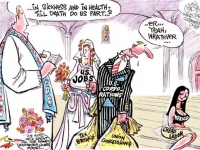The Great American Jobs Scam

Lurking within the records of most cities and states in America there lies a scandal. A tax scandal. A jobs scandal. A corporate and political scandal.
It's the Great American Jobs Scam: an intentionally constructed system that enables corporations to exact huge taxpayer subsidies by promising quality jobs - and then lets them fail to deliver. The other benefit often promised - higher tax revenues - often proves false or exaggerated as well.
Take for example: New York City, which must hold the record for job blackmail, though it is hardly alone. One study of 80 companies that had received "retention" subsidies from the Big Apple found that at least 39 had later announced major layoffs, or they had entered into large-scale mergers or put themselves up for sale - events that usually trigger mass layoffs. A detailed analysis of 10 subsidized companies found they had a total loss of more than 3,000 jobs.
Bank of America, for example, received two "job retention" subsidies from New York City, in 1993 and in 2004. The 1993 subsidy was given to induce the bank to move employees into the World Trade Center following the 1993 bombing. In exchange for at least $18 million in benefits, the bank promised to retain at least 1,700 jobs in Tower One for 15 years. Instead, it laid off at least 800 people in 1997 after merging with Security Pacific National Bank. This was such a severe drop in employment that the city canceled the subsidy in 1998, but didn't require Bank of America to refund any past subsidies.
After it was displaced by the attacks of September 11, 2001, Bank of America won a new subsidy in 2004 for the consolidation of several offices into a new headquarters building in midtown Manhattan. The deal is supposed to retain 2,995 jobs and create as many new jobs over 25 years. The state and city offered a total package of $82.6 million. The Bank also got $650 million in triple-tax-exempt "Liberty Bonds," special low-interest loans enacted for New York City following the September 11 attacks. But shortly after the deal closed, Bank of America merged with Fleet Bank (which had also received an NYC job-retention subsidy). The new entity announced it would cut a total of 17,000 jobs nationwide. The overall job impact on New York City was unknown as of late 2004.
$50 Billion A Year
Scams like this cost taxpayers an estimated $50 billion a year in total spending by states and cities. The bottom of the iceberg - in every sense of the word - is the tax breaks. Those granted by states - income, sales, and excise taxes - are the least visible, least accountable, and most corrosive means by which states fund job creation. Those granted locally - in particular, property tax abatements and diversions - are especially harmful to schools.
Look up the names of corporations that have received taxpayer subsidies in the name of jobs. Almost every big company has gotten them. In fact, the average state now has more than 30 economic development subsidies, many of which are locally granted by cities and counties. These subsidies include property tax abatements, corporate income tax credits, sales and excise tax exemptions, tax increment financing, low-interest loans and loan guarantees, free land and land write-downs, training grants, infrastructure aid - and just plain cash grants.
Chances are you will find companies - many companies - that have failed to create or retain as many jobs as they said they would. Companies that are paying poverty wages or failing to provide healthcare to their employees. Companies that are abandoning our cities and sprawling onto farmland and natural spaces. Even companies that are outsourcing jobs offshore.
Dig a little deeper and you'll undoubtedly find companies that have not created any new jobs - even some that have actually laid people off since they got the subsidies. Other companies that have gotten paid just to move existing jobs from one place to another, where they are proclaimed to be "new jobs."
How can companies get away with this? Because the system is rigged. Corporations have it down to a science. They have learned how to chant "jobs, jobs, jobs" to win huge corporate tax breaks - and still do whatever they wanted to all along, including actually laying people off.
Call Centers
The impact of call centers points to the prevalence of corporate job scams in rural as well as urban areas. Call centers - offices where people make outbound calls trying to sell things or receive inbound calls for customer service - are a major source of employment in the United States. Trade associations claim they account for about three million jobs. They are often touted for their job creation in small cities and rural areas. Requiring inexpensive equipment that takes little time to set up, call centers can create jobs quickly, especially now that fiber-optic telephone lines are more common. But they can also leave town just as fast.
Tampa-based Sykes Enterprises Inc. operates call centers in the United States and abroad. The company has a widespread history of receiving subsidies, typically in small cities or rural areas. Indeed, a company vice president once said: "Every one of our locations is a result of some incentive plan. If a community is inviting Sykes to build a call center, they are expected to deed the land for two call centers to us, and give incentives of at least $2.5 million."
The trouble is, employment in the facilities fluctuates a lot, and the company has closed many of them.
In Kansas, the city of Manhattan and the state offered Sykes a subsidy package of about $6.2 million in 1998 based on its promise to create an estimated 432 jobs. From the city came a $2.6 million cash grant, free land, $500,000 for site improvements, and property tax reductions for five years. The state provided $550,000 from an "Economic Opportunity" fund, enterprise zone tax breaks worth nearly $1.8 million, and a project and training grant of $800,000. In June 2004, the remaining 256 workers lost their jobs when Sykes moved the work to Asia and Latin America. The Manhattan plant closed only six months after the enterprise zone tax breaks expired.
The job scam industry relies on an all but unknown group of key actors attracted by the $50 billion-a-year pot: secretive site location consultants who specialize in playing states and cities against each other; "business climate" experts, with their highly politicized interpretations of tax and jobs data. The system includes an organized corporate network orchestrating attacks on state tax systems; rented consultants proffering rosy projections about job creation and tax revenue; subsidy-tracking consultants to help companies avoid leaving money on the table; and even an embryonic industry that's helping businesses buy and sell economic development tax credits.
Site Location Consultants
Site location consultants are among the most powerful yet least regulated consulting industries in America. Most avoid publicity like the plague, yet they are in the middle of the majority of high-profile deals. Their tactics they use--pitting one location against another in a job creation auction-- have raised serious questions about conflict of interest, because many work for both sides of the street: for companies looking for places and for places looking for companies.
"Site consultants" said the Baltimore Sun's Jay Hancock, "think about states the way 17-year-old boys think about 17-year-old girls.'
This dual role gives them inordinate power, and they are central figures in the creation and escalation of the subsidy-bidding wars for jobs. They have a monetary self-interest in this escalation, because it makes their work more valuable and because they sometimes work on commission, taking a cut of the subsidies they help companies negotiate. They are the rock stars in expensive suits at economic development conferences, before whom public officials line up to give their cards. They are the shock troops of the corporate-orchestrated "economic war among the states" that is slashing corporate tax rates and manipulating state and local governments everywhere
Despite billions spent luring higher wages, better benefits, a stronger tax base, or better public services, in the last quarter century most workers' wages have stagnated or fallen, healthcare has become less affordable and available, and pensions have shrunk in number and value. States and cities have developed structural budget deficits, forcing cutbacks in everything from school programs to infrastructure maintenance.
And those cutbacks are particularly hard when coupled with poverty wages. An analysis of more than 500 deals all over Minnesota found that almost two-thirds of the companies it had subsidized were paying wages so low a family of three would qualify for Medicaid, and more than a fourth paid so low the same family would qualify for food stamps.
In Kentucky, in just one two-year period, the state had granted tax breaks to at least 31 companies that paid average wages below the federal poverty line for a family of four, according to Kentucky Economic Justice Alliance. In the same period, KEJA found 10 deals in which tax credits exceeded $100,000 per job.
When uniform maker Cintas announced a sewing plant in Kentucky's city of Hazard in 1993, it was given a $1.6 million building and $2 million of equipment, no corporate taxes, plus the company got to keep taxes deducted from the employees' paychecks. The pay: $5 an hour. Bill Bishop of the Lexington Herald-Leader who had been documenting how the Kentucky Rural Economic Development Act and other subsidies were attracting poverty-wage jobs, argues that poor wages create no tax base and that "low-wage industries, once settled in an area, work hard (and successfully) to keep high-wage businesses out." Kentucky, he noted, was following the path of Arkansas, where a retired economist who had studied the subsidies-for-low-wages strategy called it "rural ghettoization." Declining schools and roads drove prosperous people out, putting the economy and tax base into a downward spiral.
Of course, the all-time poster child for hidden taxpayer costs must be Wal-Mart. The world's biggest retailer has benefited from more than $1 billion in bricks-and-mortar subsidies. Those are the front-door costs. The back-door costs are the safety-net expenses to help Wal-Mart workers and their families survive on everyday low wages. U.S. congressional staff have estimated that each Wal-Mart store with 200 employees costs federal taxpayers $420,750 a year. That's when you add up costs for programs such as State Children's Health Insurance Program, Section 8 housing assistance, free or reduced-price school lunches, the Earned Income Tax Credit, and low-income energy assistance.
Stealing Shoppers
At the core of this scandal are corrupted definitions of "competition" that obscure cause and effect. We must create no-tax zones for factories, say the governors, to be competitive with other states - even though the whole country is bleeding manufacturing jobs and the obvious issue is globalization. We have to create a new TIF district (that's "tax increment financing") and steal shoppers from neighboring suburbs, say the mayors, to compete for tax base - even though malls in older areas are dying.
Those who peddle and those who buy into these corrupted definitions salute the corporate bottom line while thumbing their noses at common sense, social science, and good government. These corruptions are the deliberate creations of a 50-year campaign by corporations to divide and conquer the states - as well as the suburbs. This corporate gospel of competition preaches that governments at all levels must not be allowed to cooperate with each other. Public relations campaigns, consulting studies, lobbying of federal and state legislators, litigation all the way to the Supreme Court - companies will do whatever it takes, but governments must not be allowed to work together against the corporate assault. They must be kept in the dark and allowed into the room only when it's time to talk about subsidies. Localities must compete for tax base by pirating jobs and retail sales from each other, even though this means chewing up farmland for wasteful sprawl and throwing away older areas, poor people, and past infrastructure investments.
At every level, this system demeans and degrades public officials: the economic development official forced to bid for an unknown company against unknown competing sites; the school board members who have no say in the property tax abatements that will corrode their budget; the revenue director whose sober advice is upstaged by the frothy projections of an economist rented by the Chamber of Commerce; the governor who overspends on a "trophy" project because she so fears being known as "the governor who lost us Mercedes-Benz." Those who would dare to ask an impertinent question are quickly singled out for ridicule and isolation: they must be against jobs.
These blindfolded public officials practice job creation guided by wolves posing as Seeing Eye dogs. Companies, on the other hand, often know just where they want to go (or stay), but create a bogus competitor in order to "whipsaw" locations against each other and get more subsidies from the place they intended to go to all along.
A retired North Carolina construction executive who had used this scam admitted during a lawsuit deposition:
"I hate to give the example, but we decided very early in the game we were going to locate somewhere in the Winston-Salem/Greensboro area and narrowed it down to Kernersville rather rapidly; but spent a lot of time in Siler City and Asheboro and other communities hearing their story, primarily to use as a leverage to get all we could out of Winston-Salem. Now I give you that as a local example. But a more recent one - in Dickson, Tennessee, we had about ten west Tennessee municipalities chasing us with all kinds of offers; although we knew through the whole process it was going to be Dickson. And it was unfair and probably, as bad as it sounds, we used the others to get what we could out of where we were going in the first place. . . . you know, I've been around it a long time; but to me it's the process. Usually, you know early where you are going, and you use your leverage."
Besides creating corporate windfalls, the Great American Jobs Scam is causing all manner of collateral damage. It was used to blunt calls for trade reform long before NAFTA. It bankrolls the pirating of one state's jobs by another state. It corrodes state budgets. It subsidizes private for-profit prisons - and hundreds of Wal-Mart facilities. And it is used to help bust unions. It subsidizes poverty-wage companies that saddle us with hidden taxpayer costs such as Medicaid and Children's Health Insurance Program bills. It is helping create a massive tax-burden shift away from big companies onto working families and small businesses. It is diverting precious resources away from the two investments that really do grow good jobs - skills and infrastructure. And just don't get me started about stadiums.
Winners and Losers
That the scam could get this far out of hand suggests a profound breakdown in whatever consensus we ever had about corporate responsibility to our society. The way you handle your money is your value system. By their rampant tax dodging, large corporations are collectively saying: We don't care if the schools fall apart and the bridges are crumbling and the public health systems are impoverished and college is becoming unaffordable. We are not all in this together. We are not investing in our communities' futures. We are disinvesting.
The only clear winners are large corporations. In return for building new facilities in many states, companies are actually getting negative income taxes. Subsidy packages routinely exceed $100,000 per job. Guess who's getting stuck with the tab. When the big boys pay less, either the rest of us pay more or the quality of our public services declines - and usually it's some of both.
And even while individual corporations rack up short-term profits from tax breaks and publicly funded incentives in the name of job creation, these policies actually harm not only the public, but the business climate as well. When big companies pay less, governments are forced either to raise taxes on homeowners and businesses that don't get the tax breaks or to cut the quality of public services (with education taking the biggest hit), or some of both. And the irony is that "the single most important factor in site selection today," according to Robert Alty, perhaps the country's most experienced site location consultant, " is the quality of the available workforce." And that quality is undermined by poor education, lack of social services and below poverty wages.
This is what economic development in the United States has become. Welcome to the Great American Jobs Scam.
This article was adapted from Greg Le Roy's new book: The Great American Job Scam: Corporate Tax Dodging and the Myth of Job Creation. LeRoy is director of Good Jobs First:



